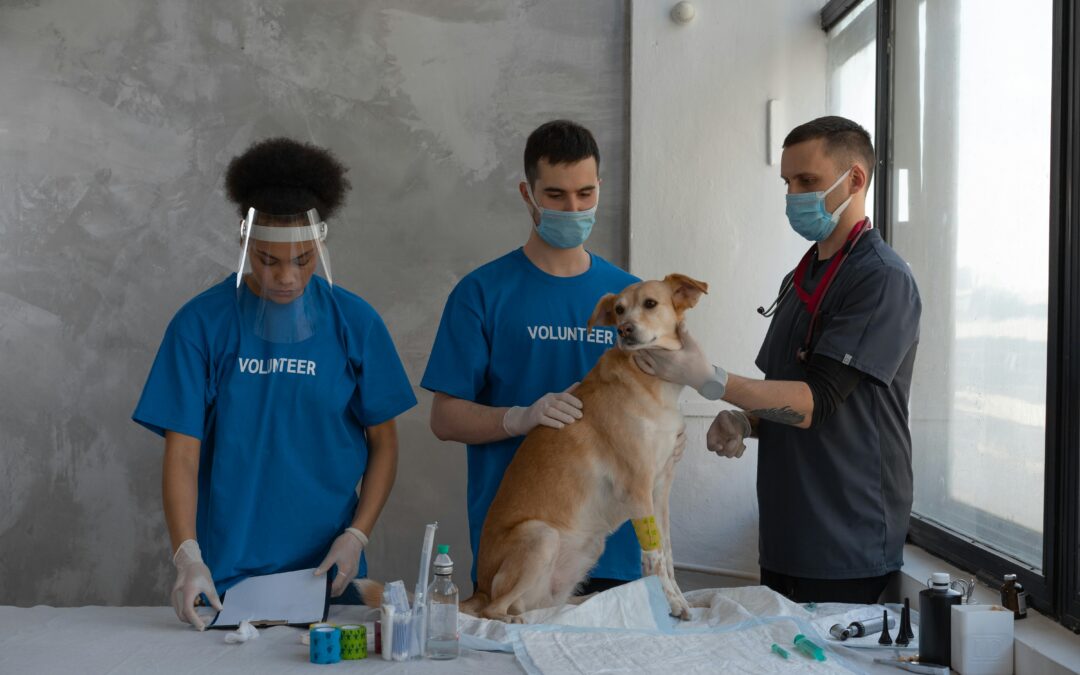Olivia was enjoying a quiet Sunday afternoon with her German Shepherd, Max. But suddenly, Max started choking on a chew toy. Olivia panicked but remembered some pet health emergency tips she had read.
Thanks to her knowledge, she could remove the toy and save Max’s life. This story shows how important it is to be ready for a dog health emergency. Knowing first aid can be a lifesaver in urgent situations.
Handling emergencies like bleeding, poisoning, or broken bones needs quick and calm action. This guide will teach you key First Aid Tips for Dog Emergencies. You’ll be ready for anything that comes your way.
Key Takeaways
- Understanding first aid techniques can save your dog’s life in a pet health emergency.
- Quick, calm action is critical in a dog health emergency.
- Preparation is key: have a well-stocked pet first aid kit ready.
- Recognizing symptoms of shock, choking, and poisoning can improve outcomes.
- Emergency care for dogs includes a variety of techniques for different situations.
Why Understanding Pet First Aid Is Crucial
Knowing pet first aid is vital for your dog’s safety and health in emergencies. Learning the basics of canine first aid prepares you for urgent situations. This readiness is essential for quick pet emergency care and saving your pet’s life.
Reducing Panic and Stress
Staying calm in emergencies is critical for both you and your pet. Learning dog health tips and emergency skills helps you stay calm. This calmness allows you to act effectively and help your pet better.
Improving Outcomes in Emergencies
Knowing how to give emergency pet care boosts your pet’s recovery chances. With the right knowledge, you can act fast, like stopping bleeding or treating for shock. These steps can help until a vet can see your pet, improving their recovery odds.
How to Assemble a Pet First Aid Kit
Having a dog emergency kit ready is key for pet owners. Emergencies can happen anytime, and having the right items can save your pet’s health.
Essential Items to Include
When you put together your pet first aid kit, make sure to include these items:
- Gauze and bandages to control bleeding
- Antiseptic wipes and sterile dressings for cleaning wounds
- Tweezers for removing foreign objects
- Trauma scissors for cutting bandages
- A muzzle to prevent biting during treatment
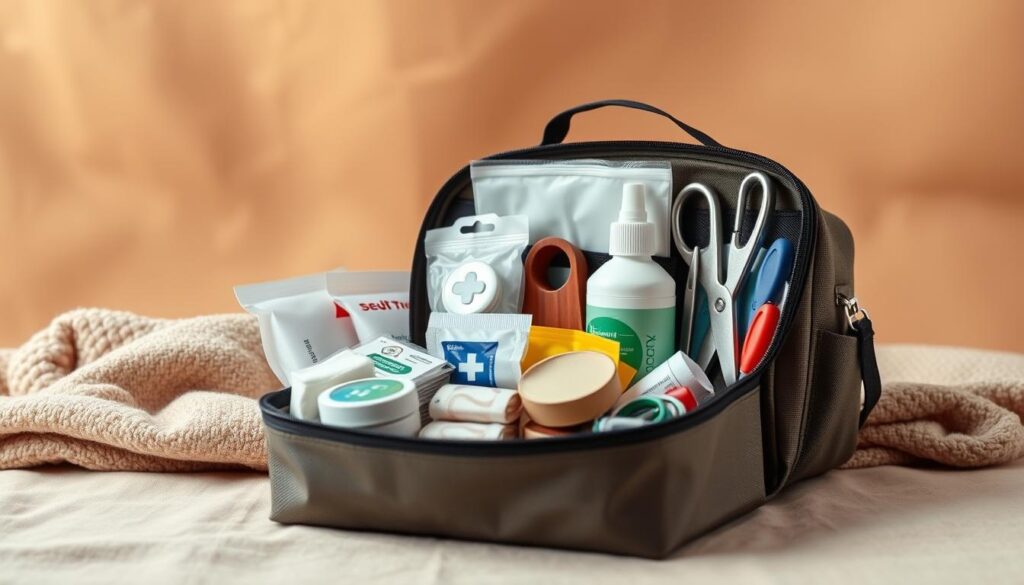
Maintaining and Updating Your Kit
It’s important to check your dog emergency kit often. Make sure all items are in good shape and not past their expiration dates. Update your kit with new products and replace used items to keep it effective. Regularly checking and updating your kit helps you stay ready and keeps your pet healthy.
Recognizing the Signs of Shock in Dogs
Shock is a serious condition that can happen when a dog is severely injured or stressed. It’s important to spot pet emergencies fast to give your dog the care they need. Knowing the signs and what to do can save your dog’s life.
Common Symptoms
The signs of shock in dogs might be hard to spot at first. But knowing what to look for is key:
- Rapid or shallow breathing
- Weak or rapid pulse
- Pale gums
- Lethargy
- Disorientation
If you see any of these signs, act fast. It’s part of being ready for emergencies with your dog.

Immediate Actions to Take
When your dog shows signs of shock, acting quickly and calmly is vital. Here’s what to do:
- Keep your dog warm: Use blankets or towels to keep their body heat up.
- Calm your dog: Talk to them softly to help them relax.
- Position your dog: Lay them on their side to help blood flow.
- Seek urgent pet care: Call your vet right away and tell them what’s happening.
By spotting shock early and taking the right steps, you can help your dog until the vet gets there.
Steps to Control Bleeding
When your dog gets hurt, it’s key to stop the bleeding. Start by applying gentle but firm pressure with a clean cloth or gauze on the wound. This first step helps reduce blood loss and lets you see how bad the injury is.
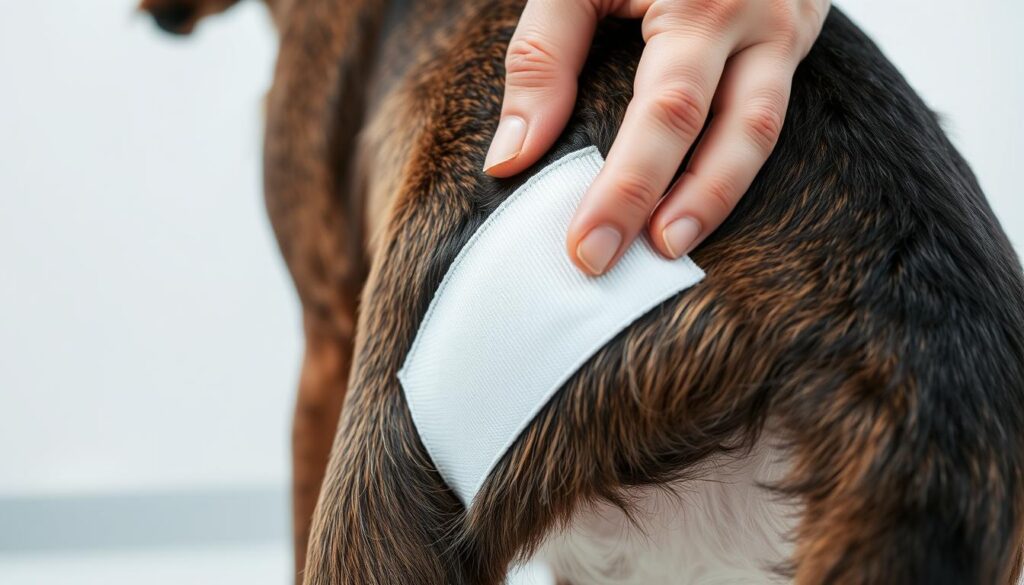
If the bleeding doesn’t stop, put a sterile dressing over the wound and keep the pressure on. Don’t lift the dressing to check the bleeding, as this can mess up clotting. These steps are important for treating injuries and helping your dog recover in emergencies.
If the bleeding is severe and won’t stop, keep the pressure on and get to the vet right away. Vets may use more advanced treatments to help your dog. Quick and right actions can help your dog’s chances of getting better.
How to Stabilize Broken Bones and Sprains
Knowing how to handle fractures and sprains in dogs is key. The aim is to stop further harm until you can get your dog to a vet. Here are some steps for stabilizing fractures in dogs and treating sprains:
- First, stay calm and make your dog as comfy as you can. Try not to move them too much to avoid making the injury worse.
- For broken bones, look for something sturdy like a splint or a stick. Gently place it along the injured limb to support it.
- Use an elastic bandage or cloth strips to hold the splint in place. Wrap it around the limb but don’t make it too tight. This could cut off blood flow.
- For sprains treatment in dogs, immobilize the limb the same way. Also, apply an ice pack to the area. This helps reduce swelling and eases pain during transport.
Remember, proper emergency care for dogs means knowing how to handle different injuries. Getting professional vet help is essential for full treatment and recovery.
Addressing Choking in Dogs
When your dog chokes, you must act fast. Knowing how to help a dog in distress is key. Start by doing a quick check.
Initial Check and Obstruction Removal
First, look in your dog’s mouth for any blockages. If you can’t see it or it’s hard to get to, don’t try to pull it out with your fingers. This could make things worse. Instead, use other methods that are part of a full emergency plan.

Performing Back Blows and Abdominal Thrusts
If you can’t see the blockage or can’t get to it, try back blows and abdominal thrusts. Stand beside your dog and hit them firmly on the back with your hand. If that doesn’t work, try quick, upward pressure on their belly. These steps are vital for emergency care.
If your dog loses consciousness, start CPR right away. Then, get them to a vet as quickly as you can. Knowing these steps can really help in an emergency.
Immediate Actions for Poisoning
When your dog eats something toxic, every second is critical. It’s key to quickly figure out what’s toxic. Start by watching your dog for signs and try to keep the poison’s container safe. This info is vital for the right treatment.
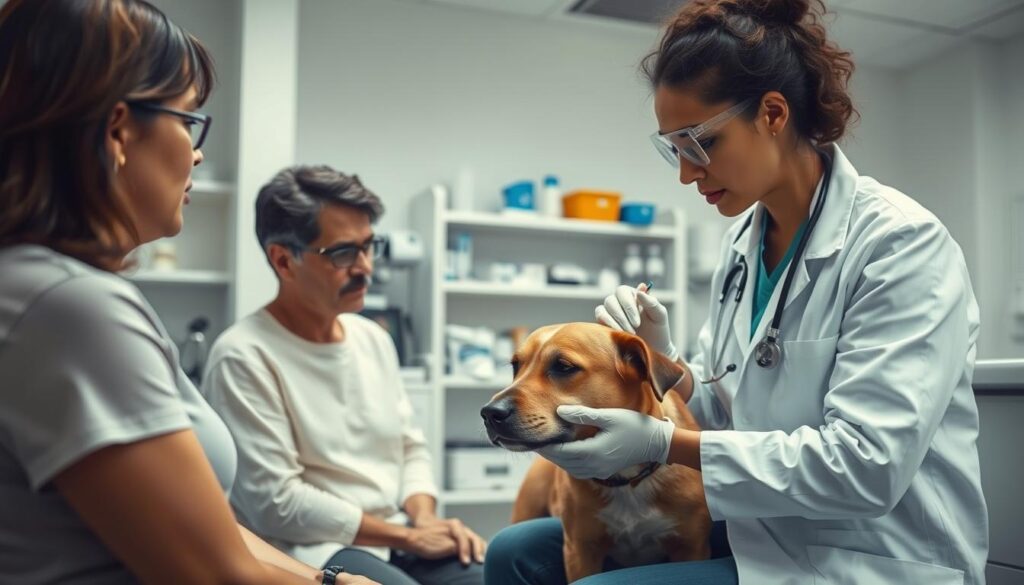
Identifying Toxic Substances
Learn about common dangers like chocolate, antifreeze, and certain plants. Knowing what your dog was exposed to helps your vet. Also, watch for signs like drooling, vomiting, or seizures that mean poisoning.
Contacting Veterinary Assistance
After spotting the toxin, call your vet or a pet poison helpline for help. They’ll tell you what to do next, like making your dog vomit or giving them activated charcoal. Quick action and expert advice are key to your dog’s recovery.
Having a list of emergency numbers, like the Pet Poison Helpline, is essential. Keep it handy so you can act fast if your dog gets poisoned.
Handling Seizures Effectively
Managing dog health emergencies like seizures requires quick action and preparation. The first step is to ensure your dog’s safety. Clear the area of objects that could harm them. It’s important to stay calm and not restrain your dog during the seizure.
Take note of how long the seizure lasts and any symptoms. This information is key for your vet.
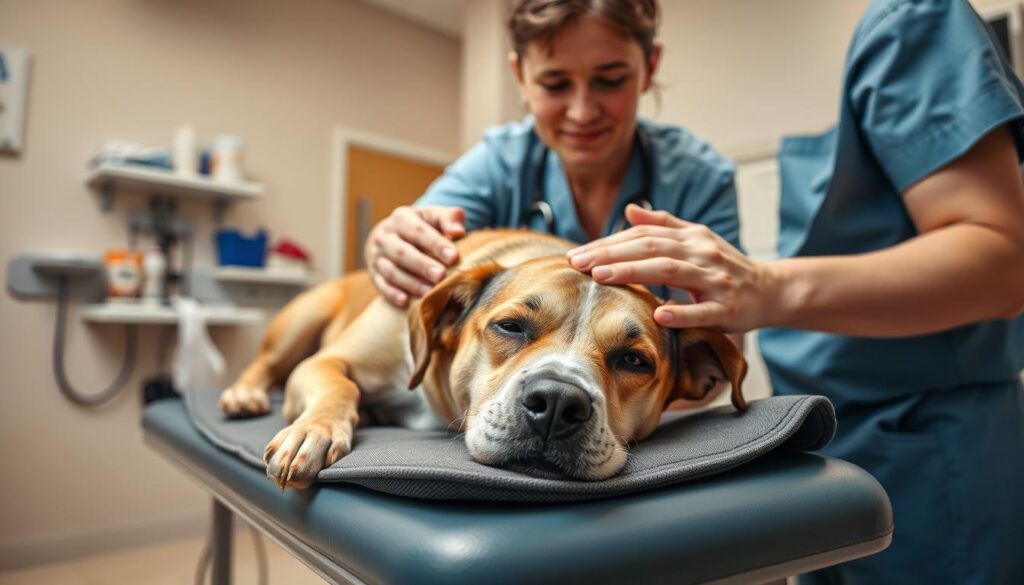
After the seizure, keep your pet in a quiet place to rest. Watch their breathing and comfort closely. Call your vet to discuss the seizure and what to do next.
Knowing how to treat dog seizures and having a plan is part of effective emergency response. Being prepared helps ensure your pet gets the best care.
Treating Heat Stroke and Hypothermia
Your dog’s health is very important, even more so when dealing with temperature emergencies. We’ll share how to manage dog heat stroke and treat hypothermia with fast and effective tips.
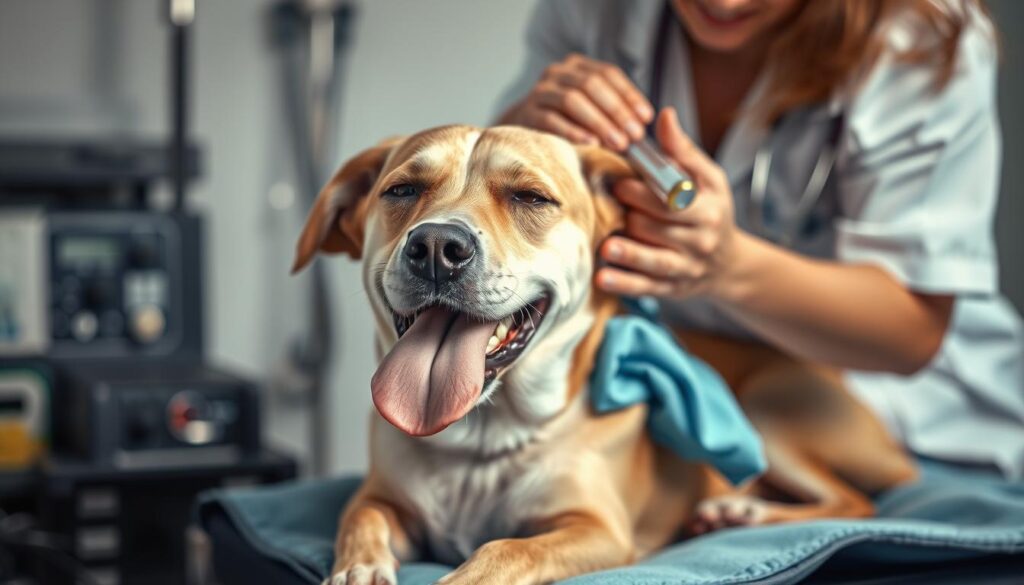
Cooling Down a Dog
Act fast if your dog has heat stroke. Move them to a cooler spot right away. Use water on their belly and paws, and give them small sips of cool water.
These steps are critical in managing dog heat stroke. They can greatly help. Always get professional help to avoid any problems.
Warming Up a Dog
If your dog has hypothermia, take them to a warm place. Wrap them in blankets to slowly warm up. But, avoid using direct heat like heating pads to prevent burns.
Quick action is key to treating hypothermia. Always get your vet involved to handle severe cases or underlying health issues.
First Aid Tips for Dog Emergencies
When a dog emergency happens, time is of the essence. Knowing what to do can save your pet’s life. By giving emergency first aid, you can keep your dog stable until help arrives. Here are some important tips for handling a dog emergency:
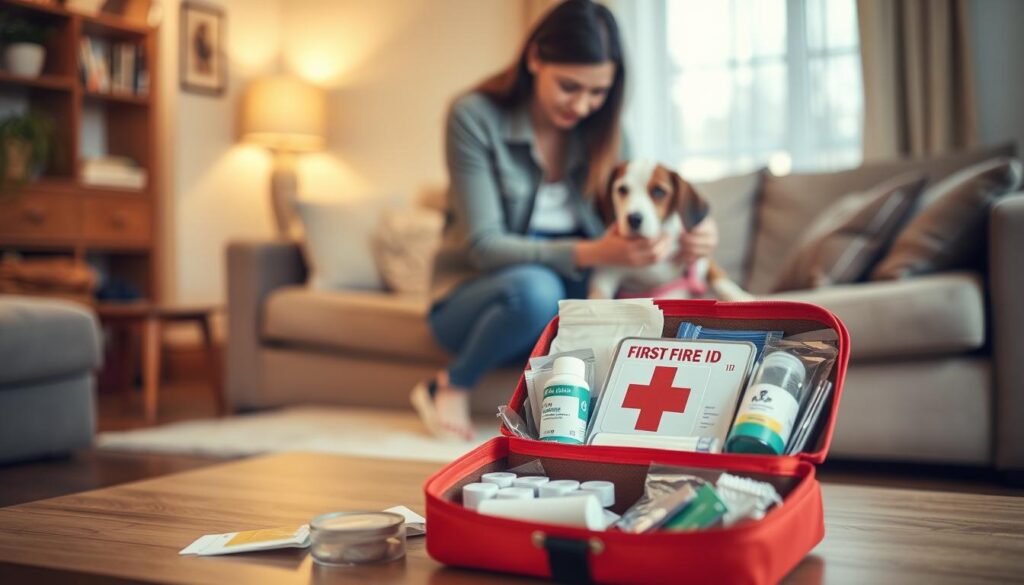
- Stay Calm: Dogs sense our emotions. Keep calm to help your dog stay calm too.
- Check Airways: Make sure your dog’s airway is clear. If they’re choking, use the right method to remove the blockage.
- Control Bleeding: Use a clean cloth to apply pressure to the wound. Elevating the limb can also help slow bleeding.
- Recognize Shock: Look for signs like fast breathing or pale gums. Keep your dog warm and calm if they’re in shock.
- Manage Seizures: Move things that could hurt your dog away. Don’t try to hold them. Just make sure they’re safe.
- Assess Poison Risks: Find and remove any harmful substances. Call your vet right away for advice.
These tips for handling a dog emergency help you feel more confident. Being ready and knowing what to do is part of canine emergency preparedness. Quick action can greatly improve your dog’s recovery chances.
CPR Instructions for Dogs
Knowing how to do dog CPR is key in emergency pet care. It’s vital to stay calm and follow these steps to help your dog. This can greatly increase their chances of recovery.
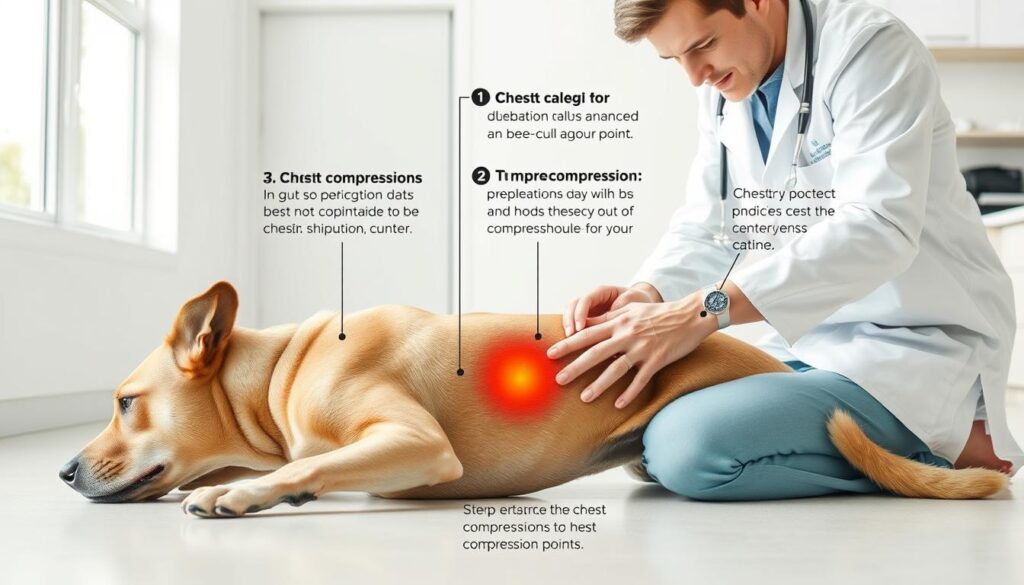
First, check if your dog is breathing and has a heartbeat. Lay your dog on their right side and watch the chest for any movement. If there’s no breathing or heartbeat, clear the airway by gently opening the mouth and removing any visible obstructions.
Next, start rescue breaths by sealing your dog’s mouth and breathing into its nose until you see the chest rise. For large dogs, give one breath every five seconds. For smaller dogs, give one breath every three seconds.
Then, do chest compressions. For large dogs, place your hands over the widest part of the chest. For smaller dogs, wrap your hand around the chest and use your thumb to compress. Keep your arms straight and press down about one-third of the chest depth. For big dogs, do 30 compressions followed by two breaths. For smaller dogs, do five compressions followed by one breath.
Keep doing these CPR steps until your dog starts breathing on its own or until you get to a vet. Quick action is essential in canine emergency care. Every second matters during this process.
Transporting an Injured Dog Safely
When your dog gets hurt, moving them safely is key. You want to keep them comfortable and avoid making things worse. Using a carrier or a stretcher can help a lot.
Using a Carrier or Makeshift Stretcher
If your dog is small, a carrier is a good choice. Make sure it’s padded and won’t tip over. For bigger dogs, a stretcher made from a blanket or board works well.
Put your dog on the stretcher carefully. This way, you won’t hurt them more.
Minimizing Movement and Stress
Move your dog slowly and smoothly. Talk to them in a calm voice to help them relax. These steps can make the trip to the vet much easier for both of you.
Finding a Pet First Aid Course
Getting a pet first aid course is key for dog owners. These classes teach you dog health tips and how to handle pet emergencies. Look for courses from trusted groups like the American Red Cross or online platforms that offer certifications.
- Choose a provider with a solid reputation in pet health.
- Ensure the course covers a range of emergencies, including choking, poisoning, and trauma.
- Verify that the instructors are qualified professionals.
By taking a pet first aid course, you learn vital skills for emergencies. This helps keep your pet safe and healthy.
Conclusion
Being ready with emergency care for pets is key to keeping your dog safe. This guide has given you useful steps and important knowledge for common dog emergencies. You now know how to handle shock, broken bones, CPR, and choking.
Being proactive about your pet’s health is very important. By having a pet first aid kit, taking a course, and knowing our guidelines, you’re ready for emergencies. Quick and calm actions can really help in these situations.
Don’t forget how important it is to talk to your vet about pet issues. Their advice is priceless for your dog’s health. With their help and your first aid skills, you can keep your dog healthy and happy.
Stay ready, stay informed, and give your dog the best care with your first aid knowledge. Your hard work can truly save lives.
